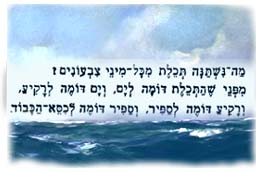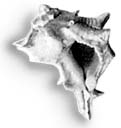 R.
Meir used to say: Why is blue different from all other colors? Because
blue is similiar to the color of the sea; the
color of the sea is similar to the color of the firmament; the color
of the firmament is similar to the color of sapphire; and the color
of sapphire
is similar to the color of the throne of glory...."
[1] R.
Meir used to say: Why is blue different from all other colors? Because
blue is similiar to the color of the sea; the
color of the sea is similar to the color of the firmament; the color
of the firmament is similar to the color of sapphire; and the color
of sapphire
is similar to the color of the throne of glory...."
[1] |
Tekhelet
is a biblical color of uncertain hue, in the blue-violet-purple family,
which was extracted from the Mediterranean mollusks of the Gastropoda
species; the mollusk, known as hilazon in Hebrew, was a snail
found in the sea between the promontory of Tyre and Haifa.[2]
The color from the mollusks was used for dyeing, and the desired shade
of blue was probably obtained by varying the dyeing process and using
different mollusks. The snail reached the shore in shoals infrequently
and the extraction of the dye was a very expensive process. And that
is why, according to rabbinic sources, "a garment made wholly
of tekhelet" was considered rare and expensive.[3]

| One
of the sea snails believed to be the source of tekhelet:
Murex trunculus. [18} |
|
The best dye was
obtrained when extracted from live snails [4]
and to make it hold, various other materials were added [5].
Most investigators incline to the view that tekhelet was extracted
from the Murex (trunculus and brandarais) snails.
Often, a "conterfeit" dye, kela ilan, extracted from
the Indian indio plant, was used to replace the tekhelet.
Tyre
long enjoyed a monopoly in the "blue" and "purple"
dye industry, the Tyrians being considered expert dyers with these materials[6]
although both colors were available and obtained elsewhere.[7]
While considered inferior to royal purple in antiquity, this "blue"
or "blue-purple" was a particularly popular color.
Tekhelet
(blue) dye was widely employed alone; however, it is frequently mentioned
in the Bible together with argaman (purple) and tola'at
shani ("crimson worm") as dye for threads and fabrics
used in the tabernacle for the curtains, the veil of the tent and for
the priest's clothing.[8]

Blue
is mentioned together with scarlet and purple as prominent colors in
the dress of the Qumran priest on the occasion of battle.[9]
In
addition to priests, princes and nobles wore garments of tekhelet
[10].
It was used for the expensive blue hangings in the royal palace of Ahasuerus
and in the royal blue and white robes.[11]
In Ecclesiasticus bonds of wisdom are compared to a cord of blue,[12]
and both blue and purple are identified in the clothing of Moses.[13]
Judas Maccabeus seized cloth dyed blue as plunder.[14]
The
most well-known use of the tekhelet dye in biblical and early
rabbinic times was in preparing the threads fastened to the four corners
of the tallit, or prayer shawl, which, according to biblical
stipulation, were to have a cord of blue entwined in them. "The
Lord said to Moses as follows: Speak to the Israelite people and instruct
them to make for themselves fringes on the corners of their garments
throughout the ages; let them attach a cord of blue to the fringe (zizit)
at each corner."[15]

That
the blue cord was prepared with dye extracted from the hilazon
snail, is evident from a discussion in Mishna, which bemoans the dearth
of this dye.[16]
Because
the hilazon snail was said to appear only once in seventy years
and was scarce even in mishnaic times (and the cost of producing tekhelet
was therefore prohibitive), and because of the fear of counterfeiting
with kela ilan -- the authorities agreed that the blue cord might
be dispensed with and white threads alone be used [17]
for the zizit (although for a period many continued to fulfill
the biblical precept with tekhelet).